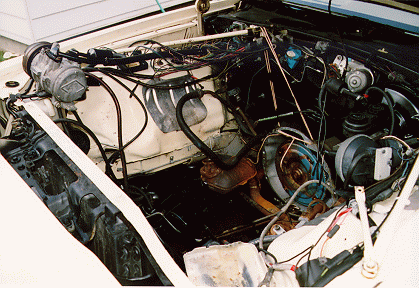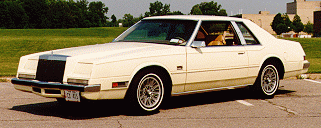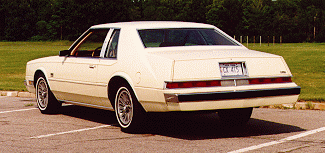 Under the hood, several people had taken
a crack at butchering the wiring harness to convert the car from the
original fuel-injection/lean-burn to a carburator and conventional ignition
system. Chrysler had been retrofitting these cars with a kit that replaced
nearly every component of the fuel and ignition systems in order to remove
the fuel injection system. While many of these kits were installed on the
cars under warranty, this car seemed to have escaped and survived the
warranty period with the fuel injection intact. When it must have become
obvious that the fuel injection system was no longer servicible, someone
tried their hand at retrofitting the car to a more conventional
fuel/ignition system.
Under the hood, several people had taken
a crack at butchering the wiring harness to convert the car from the
original fuel-injection/lean-burn to a carburator and conventional ignition
system. Chrysler had been retrofitting these cars with a kit that replaced
nearly every component of the fuel and ignition systems in order to remove
the fuel injection system. While many of these kits were installed on the
cars under warranty, this car seemed to have escaped and survived the
warranty period with the fuel injection intact. When it must have become
obvious that the fuel injection system was no longer servicible, someone
tried their hand at retrofitting the car to a more conventional
fuel/ignition system.

The vacant engine compartment after the 318 was
pulled.
This attempt left the car with a 4BBL carburator, highly modified
throttle linkage, a $10.00 chrome air cleaner, and a used electronic
ignition system that was spliced into the existing wiring harness. In the
process of performing this work, the oil pressure and temperature sensors
were left completely disconnected. Many of the modifications to the
electrical system consisted of twisted wires wrapped in electrcal tape.
Others were made with crimp-on splices and neither held up very well.
While the 4BBL manifold and carburator were to be retained, the
electrical system needed some major fixing. This posed a problem from the
standpoint of the engine wiring harness. At the first glance, it is obvious
that the Imperials had a completely different set of harnesses than any other
Chrysler product. But luckily, the engineers only added more wires and
connectors to the existing J-body wiring to come up with the Imperial
wiring. With the donation of some engine wiring from a junkyard M-body, it
was possible to convert the Imperial to the more conventional wiring of the
other 318 equipped cars. This meant that nearly everything could be
functional and integrate with the Imperial's other electrical systems.
There was one curious difference that became clear when trying to hook
everything back up. In the 1981-83 period, all V8 powered Chrysler vehicles used a
temperature guage... except the Imperial. Chrysler had decided to use an
idiot light in place of the usual guage on the Imperial. The typical sensor
varies its resistance to ground in accordance with temperature, while the
one used on the Imperial is just a temperature operated switch.. Because
the intake manifold had been replaced, the temperature sensor was from
another car. When hooked up to the Imperial, this sensor caused the idiot
light to gradulally increase in brightness as the engine warmed up. This is
not a very useful as an indication of wheather the engine is overheating.
But, a trip to the local Chrysler dealer to order the correct temperature
sensor was all that was needed to remedy this problem.
With the underhood wiring repaired, all of the other plumbing hooked
back up to the engine and the Imperial back on all four wheels, it was ready
to come back to life. After the usual basic ignition timing adjustments the
engine seemed to be running fine. No more valve clatter, no more oil leaks,
no more coolant running on the ground.
The worst seemed to be over, but there was much left to do...


 or return to the main page.
or return to the main page.
 Under the hood, several people had taken
a crack at butchering the wiring harness to convert the car from the
original fuel-injection/lean-burn to a carburator and conventional ignition
system. Chrysler had been retrofitting these cars with a kit that replaced
nearly every component of the fuel and ignition systems in order to remove
the fuel injection system. While many of these kits were installed on the
cars under warranty, this car seemed to have escaped and survived the
warranty period with the fuel injection intact. When it must have become
obvious that the fuel injection system was no longer servicible, someone
tried their hand at retrofitting the car to a more conventional
fuel/ignition system.
Under the hood, several people had taken
a crack at butchering the wiring harness to convert the car from the
original fuel-injection/lean-burn to a carburator and conventional ignition
system. Chrysler had been retrofitting these cars with a kit that replaced
nearly every component of the fuel and ignition systems in order to remove
the fuel injection system. While many of these kits were installed on the
cars under warranty, this car seemed to have escaped and survived the
warranty period with the fuel injection intact. When it must have become
obvious that the fuel injection system was no longer servicible, someone
tried their hand at retrofitting the car to a more conventional
fuel/ignition system.



 or return to the main page.
or return to the main page.